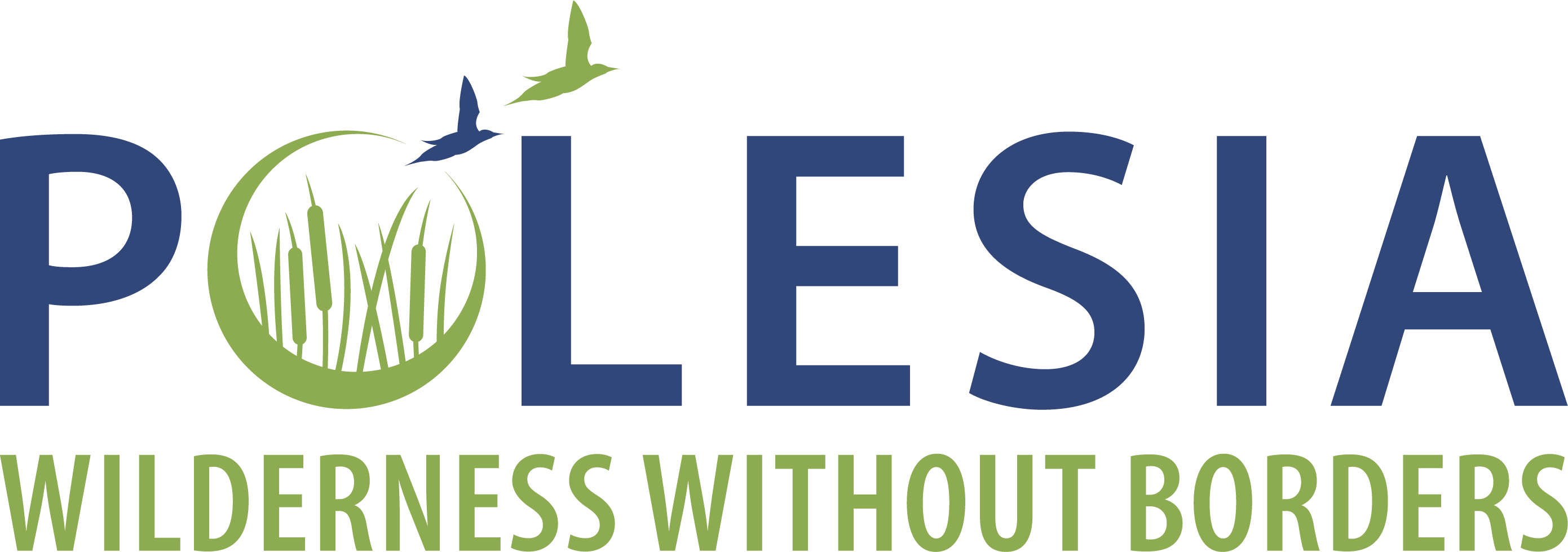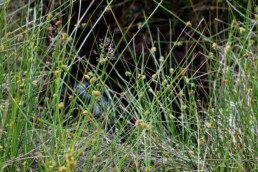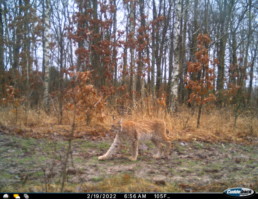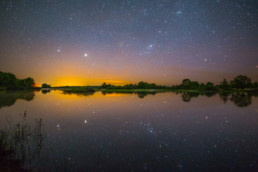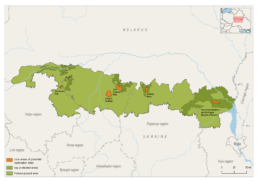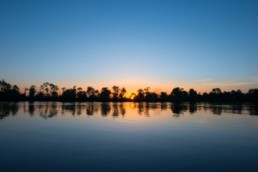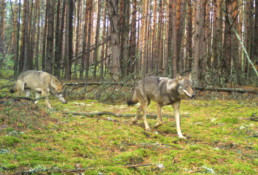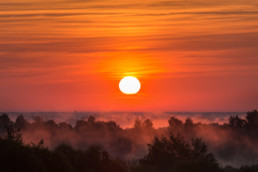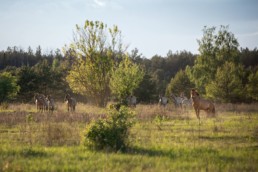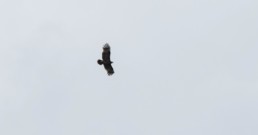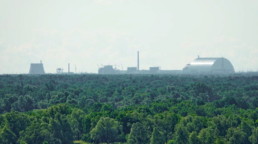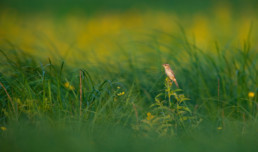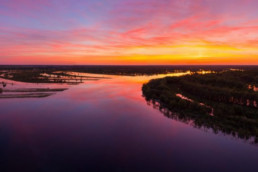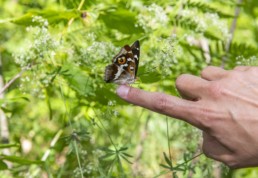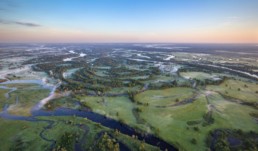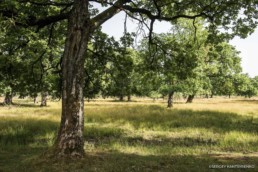Meeting on the ground: disturbed mires of Ukrainian Polesia are waiting for restoration
Meeting on the ground: disturbed mires of Ukrainian Polesia are waiting for restoration
Experts from the “Polesia – Wilderness Without Borders” project and our partner organization the Michael Succow Foundation visited Ukraine. The visit was dedicated to the prospective restoration of disturbed and degraded mires in the Ukrainian part of Polesia. Its program included meetings with stakeholders, trips to protected natural areas and a round-table session.
The delegation’s members discussed the cooperation prospects with executives and employees of Cheremskyi, Rivnenskyi and Poliskyi nature reserves as well as the Chornobyl Radiation and Ecological Biosphere Reserve. In all these protected areas there are drained mires with good prospects for successful restoration – its feasibility was assessed by experts of the Michael Succow Foundation.
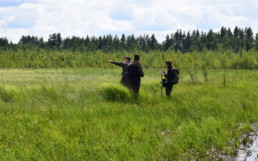
An important task was to listen to opinions of different groups of stakeholders. The position of specialists of the nature reserves is clear: they know the benefits of the mires’ restoration better than others and therefore highly appreciate the international assistance in organizing this work and demonstrate their willingness to cooperate. Their support is extremely valuable, just like the one of the State Agency of Water Resources of Ukraine.
At the same time, the opinions of the local communities are not always unambiguous. On the one hand, a stricter protection regime and rewetting of drained areas may mean certain limitations for economic activities of the local residents. On the other hand, lack of pure water caused by drainage is the argument that makes many people change their minds in favor of the mires’ restoration.
Olga Denyshchyk, scientific project coordinator at the Succow Foundation
"All the stakeholders in Ukraine are constructive, interactive and ready to cooperate more than ever before. This is truly inspiring. Peatland restoration is getting a strategic meaning, not only as freshwater reservoir, but also as a defense line. A lot of communities in Polesia are looking for investors and ready to consider any ecologically-sustainable offer. If you have something in mind, please do reach us out!"

Members of the foreign delegation accompanied by Ukrainian experts visited Cheremskyi, Rivnenskyi and Poliskyi nature reserves to learn more about them on the ground. Each of the reserves has its peculiarities, and the areas to be restored have different degrees of disturbance, spatial organization and features of drainage systems.
Mykhailo Franchuk, deputy director of the Rivnenskyi Nature Reserve:
“Mires make up 50% of the territory of the Rivnenskyi NR, and 20% are covered with fen forests. Over the past 100 years, they have been subjected to significant anthropogenic impact. I mean land reclamation, peat mining and illegal amber mining. As the climate changes intensified in recent years, the disturbed marshes with unstable hydrological regimes have become very vulnerable - the water disappears from wetland areas quicker than before. As a result, droughts, the transformation of typical marsh biotopes, and the biodiversity loss have intensified.
It is important for the Rivnenskyi NR to conserve the mires because it was created to protect the typical natural complexes of Polesia and is the largest marsh reserve in Ukraine. Currently, the reserve protects 13 communities of the Green Book of Ukraine. 53 species of plants, 106 species of animals occurring here are listed in the Red Book of Ukraine, 38 animals belong to the IUCN Red List.
The mires need saving! And restoration of the hydrological regimes planned within the framework of the project "Polesia - Wilderness Without Borders" is timely and necessary. I hope that our joint work will help to retain water in the mires and mitigate its loss”.
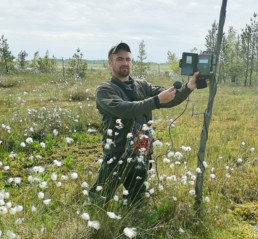
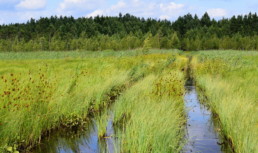
It has been decided that prior to the construction works, experts will conduct a one-year-long hydrological monitoring as well as peat layer analysis. It will allow assessing the present water levels in the project territories and then evaluating the efficiency of the restoration. The proposed monitoring methodology and further modeling based on the data obtained was elaborated and successfully tested by Polish experts.
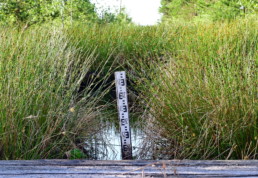
During a round-table session that took part at the National University of Water and Environmental Engineering in Rivne, experts discussed the value, present state, threats and prospects of the Polesian wetlands. Among other topics, they touched upon the historical importance of mires as natural barriers during military conflicts which is unfortunately up on the agenda today. We hope that this aspect will lose its urgency very soon. However, mires in Polesia, being a source of drinking water for millions of people, an effective carbon storage and a hotspot of biodiversity, are worth being restored and preserved for generations to come.
Anthropogenic factors limit suitable habitat for wolves in Polesia
16. November 2023
0 Comments7 Minutes
The project “Polesia – Wilderness Without Borders” is part of the Endangered Landscapes & Seascapes Programme and is funded by Arcadia. The project is coordinated by Frankfurt Zoological Society (FZS).
Natural hydrological regimes are key for Polesia's resilience to devastating landscape fires
New study: natural hydrological regimes are key for Polesia's resilience to devastating landscape fires
Landscape fires disproportionally affect areas of conservation priority but only under low moisture conditions - this is the conclusion of the new peer-reviewed study where scientists mapped and analyzed large fires that occurred over a 19-year period in Polesia, a region containing some of Europe’s last pristine peatlands and lowland forests in Eastern Europe.
Fires are of great concern to policymakers in the region due to the economic and health costs, and a lot of resources are used to suppress fires during hot and dry years. There are potentially natural solutions to fires, however, that could also benefit birds, biodiversity and climate issues. These ‘nature-based’ solutions include restoring drained wetlands. In this study, freely-available satellite data were used to explore the prevalence of large fires and the factors causing them. This allowed researchers to explore whether restoring the landscape’s wetlands could reduce the increasing risk of large, damaging fires as the climate changes.
This study identified five fires reaching more than 100 km2, a threshold often used to classify ‘megafires’. Frequent spring and summer fires predominantly started in agricultural areas, where farmers burn the land to clear it, both before planting and following the harvest. However, these fires often spread into neighbouring peatlands and floodplain meadows, endangering threatened wildlife, such as the Greater Spotted Eagle and Aquatic Warbler, and damaging a globally important carbon sink.
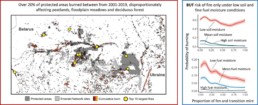
The largest fires burned in native deciduous forests, threatening protected old-growth oak and beech forests, which are more vulnerable and less likely to recover than more fire-adapted trees. Overall, more than one fifth of protected land burned. This is compared with 8% of unprotected land. One fire reached 97 km2 and burned significant areas of the Chernobyl Exclusion Zone, where radioactive contamination from the Chernobyl 1986 disaster is highest, and where the impacts of large fires on human health may be particularly severe.
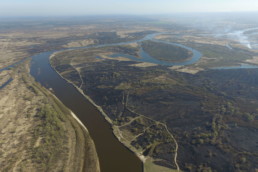
The results of the study suggest that landscape restoration in Polesia’s wetlands would help to limit the spread and intensity of unnaturally large, damaging fires, while reinstating natural, periodic low-intensity fires, providing ecosystem benefits and supporting long-term carbon storage.
Throughout Europe, including in Polesia, years of drainage for agriculture and commercial forestry has created overgrown, drier landscapes that are more susceptible to fires. This study showed that open peatlands, meadows, and deciduous forests were far more likely to burn when moisture conditions in the soil and litter were low. In contrast, peatlands were very unlikely to burn under high moisture conditions. Preserving and restoring large, intact, well-hydrated peatlands would help to create natural barriers to large, severe fires, while reinstating periodic low-intensity fires. Doing so would provide ecosystem and conservation benefits, support long-term carbon storage and help tackle climate change, and protect human lives.
The article was originally published on www.bto.org.
The project “Polesia – Wilderness Without Borders” is part of the Endangered Landscapes & Seascapes Programme and is funded by Arcadia. The project is coordinated by Frankfurt Zoological Society (FZS).
War beneath their wings: Greater Spotted Eagles are flying back to Polesia
War beneath their wings: Greater Spotted Eagles are flying back to Polesia
The spring migration of Greater Spotted Eagles has begun. Twenty percent of the European population of these birds breed in Polesia. Thanks to satellite tagging, we are able to keep a close eye on their movement. Now, researchers have special concerns about the migration of these endangered eagles: the birds’ path crosses Ukraine where the military conflict continues. While the war rages on the ground, the eagles fly their route undeterred.
Greater Spotted Eagles are returning to their nests in Polesia from the Balkan Peninsula, Israel, South Sudan, Zambia, and even South Africa. Every year, they fly thousands of kilometers to reach their breeding and wintering sites. Their journey is full of the expected difficulties and threats. However, they face another trial: the war is now right on their migration route. Polesia’s Greater Spotted Eagles faced this for the first time last spring. Ornithologist Valery Dombrovski, who has been researching Greater Spotted Eagles for decades and keeps a close eye on the GPS-tagged birds, shared some of his observations with us…
“Spring migration in 2022 was quite typical in terms of dates and average duration. But our close attention was riveted to Greater Spotted Eagles nesting in the Chornobyl Exclusion Zone – they had to cross the Kyiv region where active hostilities were going on. One of them, a male by the name of Borovets, was the first to start on his way. He followed his traditional route through Odessa and Cherkasy regions. Borovets approached Kyiv on the 29th of March, at the very moment when the Russian troops withdrew under attack by the Ukrainian forces. Borovets stopped on the left bank of the Dnieper River to wait out bad weather: the sky was cloudy, and cold rain had started. The eagle spent the following day at the same place. Sounds of explosions were heard from far away – Kyiv was still being shelled. Could the bird tell these sounds from spring thunder? It is not really possible. On the 31st of March, when the sun shone again, Borovets rushed further north.
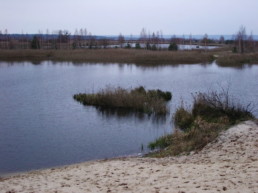
He flew above the eastern outskirts of Kyiv and then along the Kyiv Water Reservoir. With his sharp vision, it is likely he could observe long columns of military vehicles retreating from Kyiv, probably an uninteresting sight for the bird. Foul weather forced Borovets to stop again, now further up the reservoir, and about 20 kilometers from the Belarusian border. This time, he stayed in one place longer – from the 31st of March until the 3rd of April. It was quiet: explosions were no longer audible. The Russian troops had retreated from the Kyiv Region and the Chornobyl Exclusion Zone. Borovets fed happily on birds and mammals hiding in riverside reeds, and visited the farmlands around the neighboring villages.
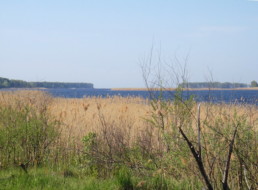
On the 4th of April, a fair wind blew from the south and drew the clouds away. Just 4 hours later, the eagle reached his nest in the Polesie State Radioecological Reserve. Fortunately, the helicopters that were flying back and forth above the reserve every day during the past month had already followed the rest of Russian military units. Thankfully, Borovets could occupy himself with his “family” concerns. During the remainder of the 2022 season, he successfully bred a chick.
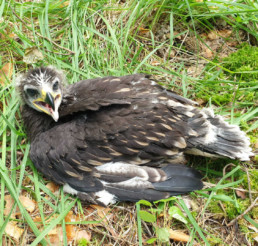
A female eagle, named Elleni, arrived in Ukraine much later. On the 4th of April, she stopped shortly in the Odessa Region. By the end of the next day, thanks to favorable weather, Elleni reached the western outskirts of Kyiv. There, she stayed overnight alongside the Irpin river. The fighting had stopped there several days earlier. The bird showed no unusual behavior. On the morning of April 6, she flew further north. Her flight path crossed now infamous places: Irpin, Gostomel, and Bucha where terrible massacres took place. Luckily, birds cannot understand such horrors. The next day, Elleni reached her nest, nearby to the nest of Borovets. Elleni’s breeding season ended with its own sadness, as her chick died in the middle of summer from an unknown cause.
In spring 2022, other Greater Spotted Eagles from Polesia flew across the Western part of Ukraine where there were no active battles. All the birds reached their nests successfully. The fastest one was Blond, on the 17th of March, he was already in his nest in Almany Mires. Most birds arrived later, in the first week of April. Vialuta was the last to return, arriving home on the 20th of April. By the way, this is the latest date of the end of spring migration for five years of observations.”
The war in Ukraine gave ornithologists not only food for thought, but also material for scientific research. We expect a research paper to be published analyzing the war’s impact upon the migration patterns of the Greater Spotted Eagles. In the meanwhile, though we can’t stop the war immediately, we hope for a safe migration back home for the birds – wild Polesia is waiting for them.
Top image fatures a Greater Spotted Eagle in flight. Photo credit: Daniel Rosengren.
Anthropogenic factors limit suitable habitat for wolves in Polesia
16. November 2023
0 Comments7 Minutes
The project “Polesia – Wilderness Without Borders” is part of the Endangered Landscapes & Seascapes Programme and is funded by Arcadia. The project is coordinated by Frankfurt Zoological Society (FZS).
Decades without man: rewilding of the Chornobyl Exclusion Zone benefits endangered birds
Decades without man: rewilding of the Chornobyl Exclusion Zone benefits endangered birds
A new study shows the benefits of restoration in countering biodiversity loss. The paper, published in January 2022 by scientists from Belarus and Great Britain, used long-term raptor monitoring data from the Chornobyl Exclusion Zone. Data for the study was collected over 22 years, in parallel to passive rewilding of the abandoned area.
The accident at the Chornobyl Nuclear Power Plant in 1986 was one of the worst nuclear disasters that ever happened. When speaking about the long-term consequences, people naturally tend to refer to the negative impact on human health and on the environment, caused by the heavy radioactive contamination. However, there is at least one additional long-run side effect of this tragic occurrence that is often overlooked: the accident paved the way for an unparalleled case of large-scale rewilding of a settled region. On about 470,000 hectares of land that had formerly been densely populated and used for intensive agriculture, human activities ceased almost completely from one moment to the next. The people who once called this region home had to move away, the farmland was abandoned, and drainage canals were locked to prevent the spreading of wildfires and contaminated water. But the retreat of the population did not mean that all life had left the area. Nature took its chance and began to reclaim the territory, at its own will and pace.
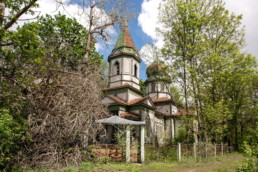
This rewilding process has been observed by researchers for more than two decades. The findings are impressive: From 1999 to 2017, the wetland area increased by 680% and forest area by 14%. Now, more than 30 years after the accident, the territory looks like Polesian wetland habitats in northern Ukraine or southern Belarus, with typical seasonal floods and large mires.
Wilderness is advancing: who wins and who loses out?
The transformation of the animal communities was expected to be enormous after the massive decrease of human impact. Over a period of 22 years – from 1998 to 2019 – ornithologist Valery Dombrovski monitored population sizes, species composition, and habitat changes of birds of prey nesting in the Chornobyl Exclusion Zone. Parts of this study were supported by the Polesia – Wilderness without Borders project. The study area spans over 14,700 hectares of former farmland that had been intensively used until 1986.
During the study period 13 breeding species of daytime predators were recorded, and both species composition as well as the number of individuals changed significantly.
For instance, the globally endangered Greater Spotted Eagle (Clanga clanga), which relies on wetland habitats to hunt and is very sensitive to human disturbance, had been locally extinct in the area at the time of the nuclear catastrophe. 33 years later, in 2019, four pairs were recorded at the study site, and at least 13 pairs were known to be nesting in the whole Belarusian part of the Chornobyl Exclusion Zone. Today, this region is the only part of the world where the population of this rare species is growing. The increase of wetland areas alongside low levels of anthropogenic influence in the Chornobyl area created favorable living conditions for the Greater Spotted Eagle, which may help save this threatened species from extinction.
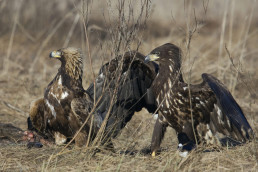
Another (locally) endangered raptor that reacts sensitively to human presence is the White-tailed Eagle (Haliaeetus albicilla). Before the nuclear accident, this bird could not be found in what is today the Chornobyl Exclusion Zone. Only in 1992, White-tailed Eagles were first sighted here, and by 2010 their number had increased to 20 pairs. Unlike the Greater Spotted Eagles, White-tailed Eagles are non-migratory, so the availability of prey in winter is crucial for their survival. And here is how the true value of rewilding reveals itself: a functioning ecological community has returned to the area, composed of various species that sustain and support each other. Along with the birds of prey, top predators like wolves as well as their prey species (such as deer and moose) established viable populations, so that there is enough carrion for the White-tailed Eagle to make it through the cold season.
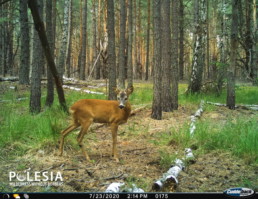
While the Greater Spotted Eagle and the White-tailed Eagle profited from the abandonment of the area, the scientists also observed decreasing populations of certain bird species. This applies to raptors that prefer hunting in farmland, such as Montagu’s Harrier (Circus pygargus), Lesser Spotted Eagle (Clanga pomarina), Honey Buzzard (Pernis apivorus), and Common Buzzard (Buteo buteo). Interestingly, at the beginning of the monitoring work in 1998, the population sizes of these species in the Chornobyl Exclusion Zone were much higher than the regional average.
Overall, the study shows that the passive rewilding of ecosystems is a complex and lengthy process. Some species needed nearly two decades to build stable populations, and others, like the Greater and Lesser Spotted Eagle, are still adapting. The Greater Spotted Eagle started colonizing the Chornobyl Exclusion Zone only 15 years after humans had left. Therefore, a long-term dynamic monitoring is the only way to assess the restoration process and the development of species composition and population sizes. But it has already become obvious that passive rewilding can bring European lowlands back to a near-natural state – both on the ecosystem as well as on the biodiversity levels.
Top image shows the view of a reactor of the Chornobyl nuclear power plant from a fire watchtower. Polesia, Ukraine. Photo credit: Elleni Vendras.
The project “Polesia – Wilderness Without Borders” is part of the Endangered Landscapes & Seascapes Programme and is funded by Arcadia. The project is coordinated by Frankfurt Zoological Society (FZS).
New partnership for the benefit of Polesia’s wetlands
New partnership for the benefit of Polesia’s wetlands
Our plans for wetland restoration in Ukraine are now supported by the Michael Succow Foundation. Through this new partnership, our colleagues are working on a feasibility assessment on prospective rewetting of drained peatlands in the Ukrainian part of Polesia.
Ecosystem-based approach: human-centered, nature-friendly
Founded in 1997, the Succow Foundation is engaged in projects of nature conservation, climate change mitigation, protected area management and sustainable land use on four continents covering a variety of landscapes. The organisation possesses extensive experience working in post-Soviet countries, including Ukraine.
Recently, the Succow Foundation team implemented a three-and-a-half-year-long project “Ecosystem-based Adaptation to Climate Change and Sustainable Regional Development by Empowerment of Ukrainian Biosphere Reserves”. The ecosystem-based approach leans upon protection, sustainable management and restoration of ecosystems in order to preserve or recover their natural properties. In turn, fully functional and sustainable ecosystems provide people with vital ecosystem services.
The benefits of ecosystem approach were demonstrated in practice in three pilot areas located in Ukrainian protected areas. Each of them boast clear and measurable outcomes. For example, due to rewetting of a drained swamp area in Roztochya Nature Reserve, wildfires don’t occur there anymore, the ground surface temperature has dropped.
The scientific knowledge and field experience of the Succow Foundation staff were summarized in lists of proposed protective measures and activities for different types of ecosystems, including wetlands. They can be used as guides in the prospective restoration projects in Polesia.
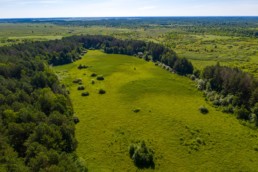
Rethinking the value of “healthy” wetlands
Wetland restoration is moving higher up on the agenda in Ukraine for a number of reasons. Wetlands of the Polesia were intensively drained mainly for agriculture production between 50th and 80th of the 20th century, which have changed the hydrological regime of the entire territory. It has led to degradation and thus in many cases abandonment of the lands, drop in groundwater levels, wildfires and droughts. Drained and degraded peatlands are sources of greenhouse gases. Particles emitted during wildfires are a dangerous air pollutant and got Kyiv to the top of the cities with the highest atmospheric pollution in 2020 and 2021.
At the same time, in their natural state wetlands mitigate the impacts of climate change due to their ability to absorb and retain carbon. When functioning properly, they protect people from extreme weather events by regulating the water flow. Wetlands serve as “kidneys of the landscape” accumulating and purifying water. The importance of Polesia’s water resources for Ukraine is immense.
Olga Denyshchyk, scientific project coordinator at the Succow Foundation
“Polesia is unique and fragile. Beyond its beauty, biodiversity, cultural and historical values, it holds the strategic water resources for the Dnieper, thus for the 2/3 of the Ukrainians who drink that water. I feel privileged to work in conservation and restoration of ecosystems. That is the best job I can imagine.”

The Russian invasion of Ukraine in the past year made Ukrainians recall another important role of wetlands, proven many times before in the course of history: barely passable, undisturbed mires and bogs serve as natural barriers against military invasion. Thus, restoration of drained wetlands in Polesia, in the vicinity to the northern border of Ukraine, would strengthen the natural defense line. Besides, natural hydrological regime of wetlands minimizes the risk of fires caused by shelling or explosions.
Turning wishes into plans
Now, when restoration of wetlands in Ukraine is likely to be supported by stakeholders, Frankfurt Zoological Society and the Michael Succow Foundation join their knowledge and experience to push this important work forward. The foundation’s experts are currently working on feasibility assessments for potential restoration sites in the Ukrainian part of Polesia, including Ramsar sites.
Anatoliy Smaliychuk, PhD in geography, GIS expert
“In my opinion, mire and old-growth forest ecosystems should be preserved and restored in Polesia foremost. Drainage and wood felling are the hurts that hardly could be cured completely. But we need to try, otherwise the natural landscapes we can observe now will be lost forever. Since the local culture and customs are closely interwoven with nature, they are under the risk of degradation as well.”
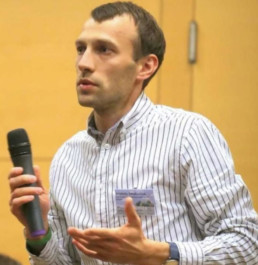
The complex assessment is expected to cover many aspects – from spatial, ecological and hydrological characteristics to legal status of territories and stakeholder analysis. This will allow the experts to determine the territories with the best prospects for successful restoration projects, plan practical restoration measures for each area and thus make our joint efforts for the benefit of Polesia’s wetlands as impactful and efficient as possible.
Top image shows a wetland in the Pripyat-Stokhid National Park in Polesia, Ukraine. Photo credit: Daniel Rosengren
The project “Polesia – Wilderness Without Borders” is part of the Endangered Landscapes & Seascapes Programme and is funded by Arcadia. The project is coordinated by Frankfurt Zoological Society (FZS).
The year 2022: conservation wins in a year of trials
The year 2022: conservation wins in a year of trials
The year 2022 was a time of bitter trials for Polesia. Once known as a territory of precious nature, it turned into a battleground during Russia’s invasion of Ukraine. As a result of the war in Ukraine, we had to revise our project since many activities became impossible in the current situation. And still, our numerous efforts undertaken in previous years bore fruit in 2022. In spite of the dramatic developments of the past year, some conservation results worth celebrating were still achieved.
Protected areas: greater size, stronger connectivity
36,000 hectares – this is the total area that gained legal protection through the creation of a new national park and a nature reserve as well as issuing protection passports for rare species’ habitat.
The year 2022 started with invigorating news: A decree issued by the President of Ukraine marked the official creation of the new Pushcha Radzivila National Park. The park protects a high conservation value area holding old-growth spruce forests, bogs and mires. Pushcha Radzivila, covering 24,265 ha , is home to more than 450 species of flora and 230 of fauna – dozens of which are nationally endangered. Among the national park’s inhabitants are Grey Cranes, Black Grouse, beavers, moose, lynx and various species of bats.
Bordering Rivnenskyi Strict Nature Reserve and Almany Mires Reserve, Pushcha Radzivila became an important link in the network of protected areas of Polesia. Through the designation of the new national park, the protection and ecological connectivity of the largest natural complex of bogs and transitional mires in Europe was enhanced.
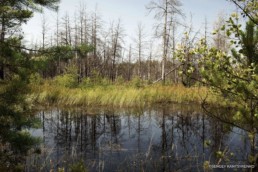
Based upon field research conducted as part of the Wild Polesia project in 2020-2021, 142 habitat sites of rare species in Polesia were placed under legal protection. Their total area amounts to 6,372 ha. Forty two species now enjoy better protection, including mammals, birds, reptiles, insects, plants and fungi. Locating and mapping the space that species need to survive and securing this habitat through the “protection passports” plays a crucial role in bringing rare species protection into effect. This procedure envisages elaboration of scientifically grounded conservation measures for each single species (and sometimes even for certain habitat sites). These measures are mandatory, and their implementation is controlled.
Meanwhile, in February, 2022, the Almany Mires Nature Reserve got a new management plan for the coming 20 years. This was preceded by months of painstaking work that resulted in the list of scientifically grounded measures on conservation and support of valuable ecosystems, and of populations of endangered species of flora and fauna, as well as ensuring sustainable functioning of the nature reserve. It is expected that these measures will mitigate or eliminate the most significant threats to the ecosystems of the Almany Mires, such as climate change, drainage reclamation, wildfires, illegal wood felling, drying up of trees, road infrastructure development, spread of invasive species of flora and fauna.
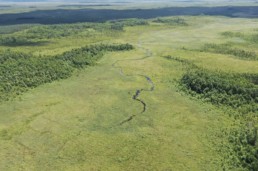
Science for Polesia: long-term monitoring in the spotlight
The natural landscape of Polesia is shaped by the Pripyat – one of the few major European rivers that are still free-flowing. Advocates for Polesia’s wilderness focus on the need to maintain the natural state of the Pripyat as a key factor for the preservation of ecosystems and biodiversity in the whole region. This message was again reinforced by a study co-authored by Pavel Pinchuk from the project published in January 2022. Summing up the results of long-term monitoring carried out from 2001 to 2020, it proves that the natural hydrological regime of rivers is extremely important for Great Snipes during their breeding season.
Competing for a mate is extremely energy-demanding for lekking male Great Snipes. Therefore, rich feeding sites in close proximity to their breeding territories are essential for maintaining good physical conditions. Up to 90% of Great Snipes’ diet is made up of earthworms whose availability depends on the water level. Low water levels allows earthworms to disperse in a deep layer of soil. While, as the water table rises, they must congregate in a narrow layer of soil close to the surface. In this case, Great Snipes have easily available prey in abundance and their physical condition improves. At the same time, a further rise of water levels associated with flooding of the Great Snipes’ feeding territories leads to a decrease of the body condition of lekking birds. This is because the earthworms leave the flooded sites; their relatively short legs also don’t allow Great Snipes to wade in deep water. Thus, the birds have to expend much more energy, flying more often and further in search of prey.
The authors of the research highlight that the natural hydrological regime of the Pripyat with seasonal water level fluctuations is important for the preservation of lowland leks of the Great Snipe and, probably, of other species of waders breeding in the floodplains of Polesia’s rivers.
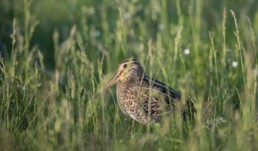
Another paper published in early 2022 looks into the unique case of wilderness restoration in the Chernobyl Exclusion Zone. The Chernobyl nuclear disaster (1986) was one of the worst man-made catastrophes in history. As a result of this tragic occurrence, in vast territories – previously densely populated and intensively used for agriculture – human activity ceased almost completely. The people who lived here up to 1986 had to relocate, the farmland was abandoned, and drainage canals were locked to prevent the spread of wildfires and contaminated water. As a result, a unique case of unguided nature restoration developed.
The long-term dynamic monitoring of landcover conducted in the Chernobyl Exclusion Zone from 1999 to 2017 shows an impressive increase in wetland and forest areas. In parallel to this, species’ composition and population numbers changed too. The monitoring of diurnal birds of prey carried out from 1998 to 2019 proved that the Greater Spotted Eagle and the White-tailed Eagle – both wetland specialists sensitive to human disturbance that had been locally extinct in the study area – returned, and their numbers increased. At the same time, the scientists observed decreasing populations of birds of prey that prefer hunting in farmland. Interestingly, at the beginning of the monitoring, the population sizes of these species in the Chernobyl Exclusion Zone were much higher than the regional average.
The study’s authors concluded that passive rewilding can bring European lowlands back to a near-natural state – at both an ecosystem and a biodiversity level.
Mapping the Polesia landscape
Another achievement by our scientists in 2022 is the elaboration of the first bespoke landcover map of the whole of Polesia. This became possible due to the meticulous work on bringing the results of large-scale field surveys into correlation with the data provided by a pair of Sentinel satellites. Google Earth Engine is used for information processing. The map identifies a set of landcover classes that can be detected from the satellite’s orbit, like farmlands and urban territories, water, deciduous and coniferous forests, meadows, bogs and mires. The tool allows experts to carry out various environmental analyses. For instance, the map enables dynamic monitoring of restoration or degradation of natural areas, changes in land use, and analyzing the intensity of seasonal floods in Polesia. The tool can also be of use for assessing landscape connectivity, mapping species distribution, or protected areas enlargement.
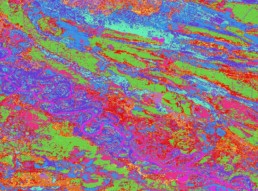
We hope that the year 2023 will be more favorable for one of largest and most valuable natural landscapes of Europe and its people. And we enter the new year eager to keep on working for the benefit of Polesia’s wilderness and the communities that call this impressive landscape home.
Top image shows the Pripyat river floodplain at sunset. Photo credit: Viktar Malyshchyc.
Anthropogenic factors limit suitable habitat for wolves in Polesia
16. November 2023
0 Comments7 Minutes
The project “Polesia – Wilderness Without Borders” is part of the Endangered Landscapes & Seascapes Programme and is funded by Arcadia. The project is coordinated by Frankfurt Zoological Society (FZS).
Where the rare things are
Where the rare things are:
mapping habitat and improving protection of rare species in Polesia bear fruit
Good news for the wildlife of Polesia! Over the past year, 142 habitats of rare species in the Lelchycy and Stolin Districts of Belarus were put under legal protection. Their total area amounts to 6 372 hectares. Thanks to our project, 42 rare species now enjoy better protection, including mammals, birds, reptiles, insects, plants and fungi. Among them are the Greater Spotted Eagle and the Azure Tit, the Weasel and the Hazel Dormouse, the Pond Turtle and the Great Raft Spider, the Oblong-leaved Sundew and the Maitake mushroom.
Rare species of animals, plants and fungi that are endangered and subject to protection are listed in the “Red Book of Belarus”. But in order to bring their protection into effect, all individual habitats of these species must first be identified and registered. This is a complex procedure and requires the participation of a number of specialists and institutions. The identification of habitats usually happens within the frame of scientific field surveys, forest management or environmental protection actions. Sometimes also lay persons detect and report habitats, however, only qualified specialists can document them for the official registration process.
The next step is the preparation of a “habitat passport”. The passport needs to contain the name of the species, photos, description and coordinates of the location, the number of individuals, and an assessment of the overall state of the population.
Along with the passport, conservation obligations are issued. They list the necessary conservation measures and determine who is responsible for their implementation. Usually, it falls to the land user. This may be a legal entity (such as forestry), a sole proprietor or even a private person.
Passports and conservation obligations are sent to the local Inspection of Natural Resources and Environmental Protection, and then to the National Academy of Sciences for verification and approval. The agreed documents become the basis for the decision of local authorities on placing the habitats of rare species under protection. Now, conservation measures are legally justified! Their implementation is monitored by the Ministry of Natural Resources and Environmental Protection and its local offices.
What exactly needs to (or mustn’t) be done to save a rare species?
Obviously, protective measures are not the same for plants and fish, insects and fungi, reptiles and birds.
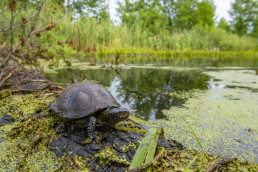
The survival of the European pond turtle (Emys оrbicularis) directly depends on the preservation of swamps and river floodplains. Where pond turtle habitats are registered, drainage for land reclamation is prohibited. Groundwork is not allowed either in order to protect eggs and young turtles. Strict regulations also apply to the management of water bodies: they mustn’t be artificially deepened and straightened, and aquatic plants may not be extracted or destroyed.
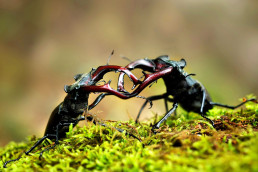
Larvae of a stag beetle (Lucanus cervus) need several years to develop during which they live on dead trees and feed on rotten wood. This is why the felling of old broad-leaved forests – especially oak-woods – the removal of dead trees and windbreak pose significant threats to this rare insect species. Cutting down old and withered trees, deploying chemicals or burning dry vegetation and logging waste are therefore forbidden in areas adjacent to stag beetle habitats.
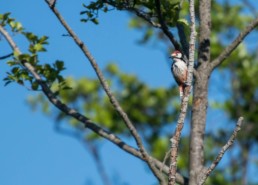
Another “Red Book” species is the white-backed woodpecker (Dendrocopos leutocos). These rare birds build their homes in rotten trees and feed on insects they find under the withered bark. Therefore, not a single tree may be felled in territories where the white-backed woodpecker is found. To avoid disturbance during the nesting season, hunting and logging are prohibited near white-backed woodpecker habitats from March 1 to July 1.
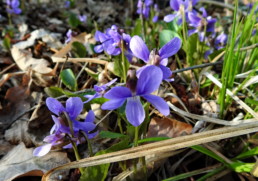
The swamp violet (Viola uliginosa) can still be found in large parts of Europe, however, numbers are declining throughout its range. Swampy terrain and seasonally flooded floodplains are optimal for this plant, so it is not surprising that in Belarus it is most often registered in the region of Polesia. In or close to swamp violet habitats drainage for land reclamation, the usage of caterpillar vehicles or any other activities that can damage or destroy the live ground cover are prohibited. Wood cutting can be carried out to a limited extent, but only if there is a stable snow cover.
We keep on searching, registering and reporting habitats of rare species of flora and fauna in Polesia to ensure their effective protection.
The top photo shows a Purple Emperor butterfly. Photo credit: Daniel Rosengren.
The project “Polesia – Wilderness Without Borders” is part of the Endangered Landscapes & Seascapes Programme and is funded by Arcadia. The project is coordinated by Frankfurt Zoological Society (FZS).
River flow affects high-energy Great Snipe lekking
River flow affects high-energy Great Snipe lekking
New study shows link between seasonal floods and Great Snipe lekking condition. The long-term research conducted at Turov Meadows in Belarus found that river water level impacts the ability of the birds to meet the high energy demands of their breeding competition. A finding that reinforces the need to maintain natural river flow in Polesia.
Each spring Great Snipes congregate in Eastern Europe’s wetlands. Rich in floodplains and marshes, Polesia offers key habitat for the waders. The birds are now listed as ‘near threatened’ with populations still in decline. A central cause of this decline is the loss of suitable habitat for breeding and nesting.
Earthworms make up 90% of the diet of Great Snipes. The location and accessibility of the worms impacts the waders’ ability to meet their resource requirements. Earthworms migrate between different soil depths depending on soil moisture. Waders rely on a rise in the water table which leaves only a narrow unflooded soil layer, forcing earthworms to congregate near the surface. Here, the birds can easily probe the softened soil with their curved beaks to extract the worms.
A good supply of food is of particular importance during the breeding season. Selection in Great Snipes takes place through lekking – a competitive behaviour exhibited by males in order to attract a mate. About 10 to 20 male Great Snipes gather in a lek where they elongate their bodies, inflate their chests, perform special songs, and flutter their wings. From time to time sparring between the males occurs.
Females choose a suitable mate based on physical attributes, but also the vigour and stamina exhibited during their lek performances. In general males with better body condition can expend more energy on lekking, winning greater attention from the females. But success in this competition demands great strain: during the mating season male Great Snipes spend four times more energy than usual. They lose about 5% of their body weight in just one night of active lekking. To regain strength and maintain good body condition during this period they must feed intensively.
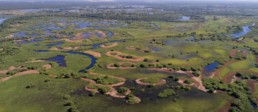
A long-term study (2001-2020) at Polesia’s Turov Meadows measured Great Snipe body size and condition and compared this data to fluctuations in the water level in the Pripyat River over time. As snow melt fills the Pripyat in spring, the water table across the floodplain rises pushing the earthworms closer to the soil surface.
At a water level in the river of 220 to 420 centimetres the body weight of male Great Snipes remained relatively stable. The layer of un-flooded soil in these conditions remains deep; the availability of prey does not change significantly. But as the water rises from 420 to 490 cm an increase in the weight of Great Snipes was observed. When the water level reaches this range, not only is the top layer of soil rich in earthworms, but also the flood loosened soil makes it easier for snipes to search for food. In such conditions, birds do not have to fly far from the breeding areas in search of feeding grounds, thus saving energy.
After the water level in the river exceeds 490 centimetres, the body weight of male Great Snipes began to decline. Under these conditions large areas become flooded, causing the earthworms to leave. The relatively short length of the Great Snipes’ legs does not allow them to feed successfully on flooded sites. The birds have to fly further in search of higher ground. Such flights and growing competition in a limited suitable habitat increases energy needs, and body condition of Great Snipes deteriorates.
Water level can therefore indirectly impact the condition of lekking Great Snipe males.
The study suggest that hydrological management of grasslands in river valleys is especially important not only for Great Snipes, but possibly also for other earthworm-feeding species. Rivers should be left unaltered to allow natural spring floods to occur. Unfortunately, only 37% of all the world’s major rivers remain free-flowing, with dams, reservoirs, water extraction, and sedimentation disrupting the natural flow of the rest. These interventions, along with the conversion of floodplain wet meadows into intensively used agricultural land with excessive fertilisation and drainage ditches created to lower the level of groundwater, are the main reasons driving the loss of suitable breeding habitat for waders.
Top image shows a Great Snipe at Turov Meadows, Belarus. Photo credit: Daniel Rosengren
The project “Polesia – Wilderness Without Borders” is part of the Endangered Landscapes & Seascapes Programme and is funded by Arcadia. The project is coordinated by Frankfurt Zoological Society (FZS).
Achieving protected status for Polesia, Europe’s largest wetland wilderness
Achieving protected status for Polesia, Europe’s largest wetland wilderness
Following important steps taken in Belarus and Ukraine to protect mires at the heart of Polesia, conservationists want to see the region awarded UNESCO status
Ahead of World Wetlands Day (WWD) on 2 February, conservationists from Polesia – Wilderness Without Borders – an Endangered Landscapes Programme supported project– are calling for Europe’s largest wetland wilderness area to be included on UNESCO’s World Heritage List.
The recent signing of a resolution to establish the Pushcha Radzivila National Park in Ukraine and last year’s expansion of the Almany Mires Nature Reserve in Belarus have provided a much-needed boost to efforts to protect Polesia, a stunning transboundary region that straddles Belarus, Poland, Russia, and Ukraine.
But threats to Polesia from human activities still loom large. Deforestation, mining, farming, and plans to construct a major waterway through the region could lead to irreversible environmental damage, experts warn.
Attaining UNESCO status would see the central part of Polesia recognised alongside the Serengeti National Park, the Great Barrier Reef, and the Iguaçu National Park on the international list of sites with outstanding universal value.
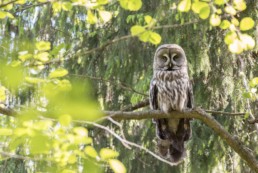
Campaigners say that achieving designated protected status for the region at an international level would help ensure the future of the largest and most important inland wetland region in Europe. It would also protect the transboundary landscape’s essential ecosystem services, which underpin hydrology, store immense quantities of carbon, and have significant potential for ecotourism.
“We want to identify and classify key areas that are not currently recognised as protected landscapes, including primary forests, other forests of high conservation value, and sites home to rare birds and mammals,” says Olga Yaremchenko of the Ukrainian Society for the Protection of Birds (USPB).
“There is an astonishing diversity of plants and animals in Polesia. The presence of species such as the Greater Spotted Eagle, the Eagle Owl, the Great Grey Owl, the Pygmy Owl, the Black Stork, the lynx, and other rare species have been identified as key indicators when identifying priority areas for such protections.”
Protecting Europe’s Amazon
During the past three centuries, close to 85% of the world’s wetlands have been drained to provide land for housing, industry, and agriculture. Those that remain are vanishing three times faster than the world’s forests.
Large parts of Polesia, on the other hand, remain in near-pristine condition. It is one of Europe’s last truly wild places. Few places on the continent provide as much space for flora and fauna to survive and thrive.
Larger in size than an average European country, Polesia is often referred to as the ‘Amazon of Europe’. The region is home to an immense patchwork of forests, peatlands, floodplains, and rivers. In springtime, snowmelt turns much of the landscape into what looks like an endless lake.
These vast habitats provide sanctuary to a number of vulnerable species, including eagles, wolves, bears, lynx, and bison. Hundreds of thousands of migratory birds pass through the region. In the springtime, numbers of at least 150,000 – 200,000 Eurasian Widgeons, 200,000 – 400,000 Ruffs, and 20,000 – 25,000 Black-Tailed Godwits have been recorded in Polesia’s Pripyat floodplains alone. It is a key breeding ground for many globally threatened species.
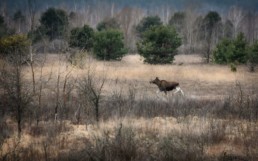
However, like many wetland areas around the world, Polesia is threatened by human activities. Besides impacts from deforestation, mining, drainage for agriculture, and infrastructure developments, the adverse effects of climate change are further reducing the resilience of its environment.
Polesia has also come under intense focus as a result of plans to construct Europe’s longest waterway through the region. Known as the E40, the waterway would connect the Baltic Sea with the Black Sea, stretching some 2,000 kilometres from Gdansk in Poland to Kherson in Ukraine. The construction could destroy much of Polesia’s vast wilderness, with researchers predicting far-reaching implications for both humans and nature.
It has led to a race against time for conservationists to document the region’s biodiversity in detail, and make the case for its protection.
Important steps taken
Many parts of Polesia are of international importance for nature conservation and have been recognised as UNESCO Biosphere Reserves, Important Bird Areas, Emerald Network, or Ramsar sites. During the past 12 months, important steps have been taken at the national level to protect further areas.
At the turn of the year, a resolution was signed by Ukraine to establish the Pushcha Radzivila National Park in the heart of Polesia. Formed largely of bogs and transitional mires, the 24,000 hectare protected area secures better protection for the area’s wildlife, improves the connectivity of protected areas, and also provides important opportunities for local communities while keeping the carbon stored in its precious peatlands.
The move followed commitments by authorities in neighbouring Belarus to expand protections of the Almany Mires Nature Reserve in March 2021. Almany was expanded by 10,000 hectares, bringing the size of the reserve up to 104,000 hectares – roughly the size of Hong Kong. Research carried out as part of the Polesia – Wilderness Without Borders project, supported by the Endangered Landscapes Programme and Arcadia – a charitable fund of Lisbet Rausing and Peter Baldwin – helped to identify crucial habitats for rare wildlife in need of protection.
Together with the newly protected areas across the border in Ukraine, the area – which sits at the heart of Polesia – forms one of the largest peatland complexes in Europe.
“The pristine ecosystems and landscapes found in Polesia are, today, extraordinarily rare on a global level,” says Maxim Nemtchinov, a nature conservation officer at BirdLife Belarus (APB).
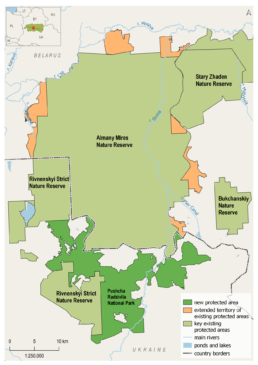
“A lot of work has been carried out by researchers and conservationists to characterise the flora and fauna in the region and ensure that this very special environment is protected from the threat of developments and construction. There are also crucial initiatives underway to restore parts of the ecosystem that have been damaged by human activities.”
Peatlands are the most carbon-dense terrestrial ecosystems. Globally, the carbon stored in them exceeds carbon stored in all other vegetation combined, including forests. Maintaining them is essential to help tackle the climate crisis. They also provide sanctuary for wildlife, spanning grey cranes, black grouse, beavers, otters, moose, bats, insects, and migratory birds.
Dianna Kopansky, who leads the Global Peatlands Initiative at UNEP, said “With most of Europe’s peatlands drained and degraded, this great wilderness is an oasis – for wildlife, people, and for our climate future. The work to expand protections and raise Polesia’s conservation status represents the action on the ground needed to fight the triple crisis we are facing and is a great contribution to the UN Decade on Ecosystem Restoration. The conservation and sustainable management of this critical trans-boundary landscape could not be more important for the people of the region.”
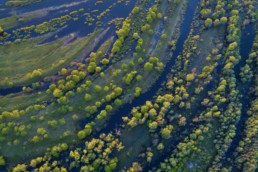
Historically, habitats such as peatlands have often been regarded as wastelands. As people don’t live on them, they can come under pressure from those wanting to turn them into farmlands or build roads across them. Many peatlands around the world are now severely degraded.
When peatlands are drained, the organic matter stored in them decays, releasing carbon dioxide into the atmosphere in the process. The dried land also becomes more susceptible to fires. The drainage of bogs and mires undermines the wider ecosystem health, its water flows, and the vital contributions they make to fresh and drinking water supplies.
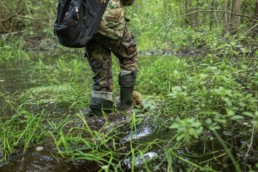
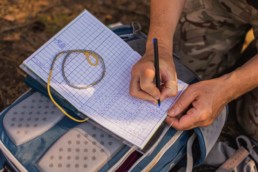
A field biologist heads into the vast Almany Mires Nature Reserve to carry out biodiversity monitoring (left); data on migratory birds observed at Turov meadows is recorded (right). Photo credit: Evgeny Gostukhin
The first priority to protect these crucial habitats is to leave them as they are. That is why conservationists are campaigning to have these and other vital habitats across Polesia recognised with protected status at both the national and international levels.
Another priority is to restore those areas that have been degraded or damaged. Peatlands typically form very slowly, over hundreds or thousands of years. But by rewetting or revegetating damaged mires, it can revitalise their carbon storing abilities and reinvigorate their habitats for native plants and animals.
Although significant areas are already under formal protection, conservationists are calling for the central part of Polesia to be recognised internationally on the UNESCO World Heritage List. They say that this is necessary to ensure adequate protection of the region’s vulnerable species and wild landscapes, and recognition of its incredible natural beauty.
————————————–
This release is part of the Global Peat Press Project (GP3) campaign, bringing together international partners to highlight the importance of peatlands as vulnerable but valuable ecosystems. It is a coordinated media outreach from UNEP’s Global Peatlands Initiative (GPI) and the North Pennines AONB Partnership to promote the UN Decade on Ecosystem Restoration (2021-2030). It was conceived to raise awareness and enthusiasm about the role of peatlands in climate action in the run-up to the UNFCCC COP26 in November, and has now pivoted to focus on the vital importance of peatlands for nature, aiming to build momentum and interest in advance of the Convention on Biological Diversity (CBD) COP15 in April 2022.
A relay of stories from peatland projects worldwide, GP3 started with the UK, as the host of COP26, which took place in Glasgow, Scotland. The relay has already featured:
– the North Pennines AONB
– the Care-Peat project in Belgium
– NUI Galway/ Insight Centre
– Five EU transnational projects (Carbon Connects, Care-Peat, DESIRE, LIFE Peat Restore, and CANAPE)
– Bax & Company who straddle the UK, Spain and The Netherlands
– Ulster Wildlife
– The Lancashire Wildlife Trust
– The GPI and EUROSITE Peatlands Social Media Campaign
– NABU
– Moors for the Future Partnership
– Metsähallitus with its Hydrology LIFE Project
– Natural Resources Wales with the LIFE Welsh Raised Bogs Project
– Community Wetlands Forum and the Landscape Finance Lab
– Terra Motion
– Green Restoration Ireland Coop (GRI)
– a major restoration effort in Belarus recognized by the Ministry of Natural Resources and Environmental Protection of the Republic of Belarus
– a second release from Ulster Wildlife
– The World Conservation Monitoring Centre (WCMC) at the UN
– Griefswald Mire Centre in Germany
– Conservatoires d’éspaces naturels in France
– the Cairngorms National Park, Scotland
– a second contribution from the North Pennines AONB
– CINEA – LIFE
– Baltic Environmental Forum Lithuania
– Yorkshire Peat Partnership
– APB-BirdLife Belarus
and now the baton is held by Frankfurt Zoological Society.
Join us – share, learn, inspire, experience and act for peatlands, people and the planet. Follow and share using #PeatlandsMatter and #GenerationRestoration.
Notes to editors:
- Full Press Release
- Wild Polesia: wildpolesia.org
- Save Polesia: savepolesia.org
- World Wetlands Day: worldwetlandsday.org
- Global Peat Press Project: https://www.globalpeatlands.org/global-peat-press-project-gp3-campaign-kick-off/
About the Polesia Wilderness Without Borders Project
The project “Polesia – Wilderness Without Borders” is part of the Endangered Landscapes Programme and is funded by Arcadia – a charitable fund of Lisbet Rausing and Peter Baldwin. The project is coordinated by Frankfurt Zoological Society (FZS) and implemented in collaboration with APB-Birdlife Belarus, the Ukrainian Society for the Protection of Birds (USPB) and the British Trust for Ornithology (BTO).
About Frankfurt Zoological Society
The Frankfurt Zoological Society is an international conservation organization. From our offices in Frankfurt am Main, our staff coordinates projects in 18 countries.
Worldwide, 440 colleagues work for FZS conservation projects. Our common goal is the conservation of wildlife and wilderness. We work where national parks and wilderness areas need our support.
Our partners include local communities, conservation authorities, national park administrations, and other NGOs. We support our partners practically, unbureaucratically, and for the long term.
About the Global Peatlands Initiative (GPI)
The Global Peatlands Initiative is an international partnership launched at the UNFCCC COP in Marrakech, Morocco, in late 2016. Led by the United Nations Environment Programme (UNEP), our goal is to protect and conserve peatlands as the world’s largest terrestrial organic carbon stock and to prevent it being emitted into the atmosphere. The GPI co-hosted the first ever Peatland Pavilion at COP26 in Glasgow in November 2021. Recordings of the sessions can be found here.
Article written by Adam Gristwood for the Polesia - Wilderness Without Borders project. Top image shows the Pripyat River floodplain. Photo credit: Viktar Malyshchyc
The project “Polesia – Wilderness Without Borders” is part of the Endangered Landscapes & Seascapes Programme and is funded by Arcadia. The project is coordinated by Frankfurt Zoological Society (FZS).
A New National Park for Polesia: Pushcha Radzivila
A New National Park for Polesia: Pushcha Radzivila
Polesia’s Pushcha Radzivila National Park secures better protection for wildlife and habitats, improves protected area connectivity, and brings sustainable development opportunities for local communities.
On the first day of 2022 the President of Ukraine signed a decree officially creating the new Pushcha Radzivila National Park. The Ukrainian Society for the Protection of Birds (USPB), as part of the Polesia – Wilderness without borders project, played a significant role in the creation of the new national park.
The park covers 24,265 hectares in Ukraine’s Rivne region. Together with protected areas in neighbouring Belarus, it forms one of the largest natural complexes of bogs and transitional mires in Europe. The area holds old-growth European spruce forests and a majestic 1,300 year-old veteran oak that measures 8 metres around the base of its trunk. Picturesque lakes and wilderness offer significant tourism development opportunities. These water bodies, together with the many swamps and wetlands in the area, are a vital water store for Polesia and Ukraine as a whole. These rare natural habitats also store massive amounts of carbon. Pushcha Radzivila forms part of the Pripyat basin playing a hydro-regulatory role for this mighty river which is the lifeblood of the Polesia region.
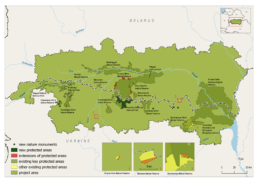
A central aim of our work is to increase the protection of these high conservation value areas. “Field experts identify and map primary forests and other high conservation value forests, as well as important sites for rare birds and mammals that lie beyond the boundaries of existing protected areas in order to apply for better protection for these sites”, explains USPB’s Olga Yaremchenko, who leads these efforts in Ukraine.
The presence of key species helps to identify important conservation areas – for example lynx, Greater Spotted Eagle and Black Grouse. Yaremchenko also emphasises that “a key component of our success in creating the Pushcha Radzivila National Park is the engagement of local communities who live nearby and understand the importance of nature conservation as the basis of a healthy life”. Thanks to the persistent support and lobbying of the communities, Rivne region managed to expand its protected area network, and thus increase the protection of Polesia.

In Pushcha Radzivila scientists have counted more than 450 species of plants and 230 species of animals, including 39 nationally endangered species. Grey Cranes and Black Grouse occur in the bogs and mires of the park. The protected area also harbours beavers, otters, lynx, moose, and almost a dozen species of bats.
Connectivity between the protected area network is enhanced – the park borders the Rivnenskyi Nature Reserve in Ukraine and Belarus’s Almany Mires Reserve in the north. The new park will thus also strengthen the protection of important wetlands in Rivnenskyi such as Perebrody Peatlands and Syra Pogonia Bog Ramsar sites.
Article written by Zanne Labuschagne, communications coordinator at FZS. Top image shows oak forests in Pushcha Radzivila National Park. Photo credit: Sergey Kantsyrenko
The project “Polesia – Wilderness Without Borders” is part of the Endangered Landscapes & Seascapes Programme and is funded by Arcadia. The project is coordinated by Frankfurt Zoological Society (FZS).
